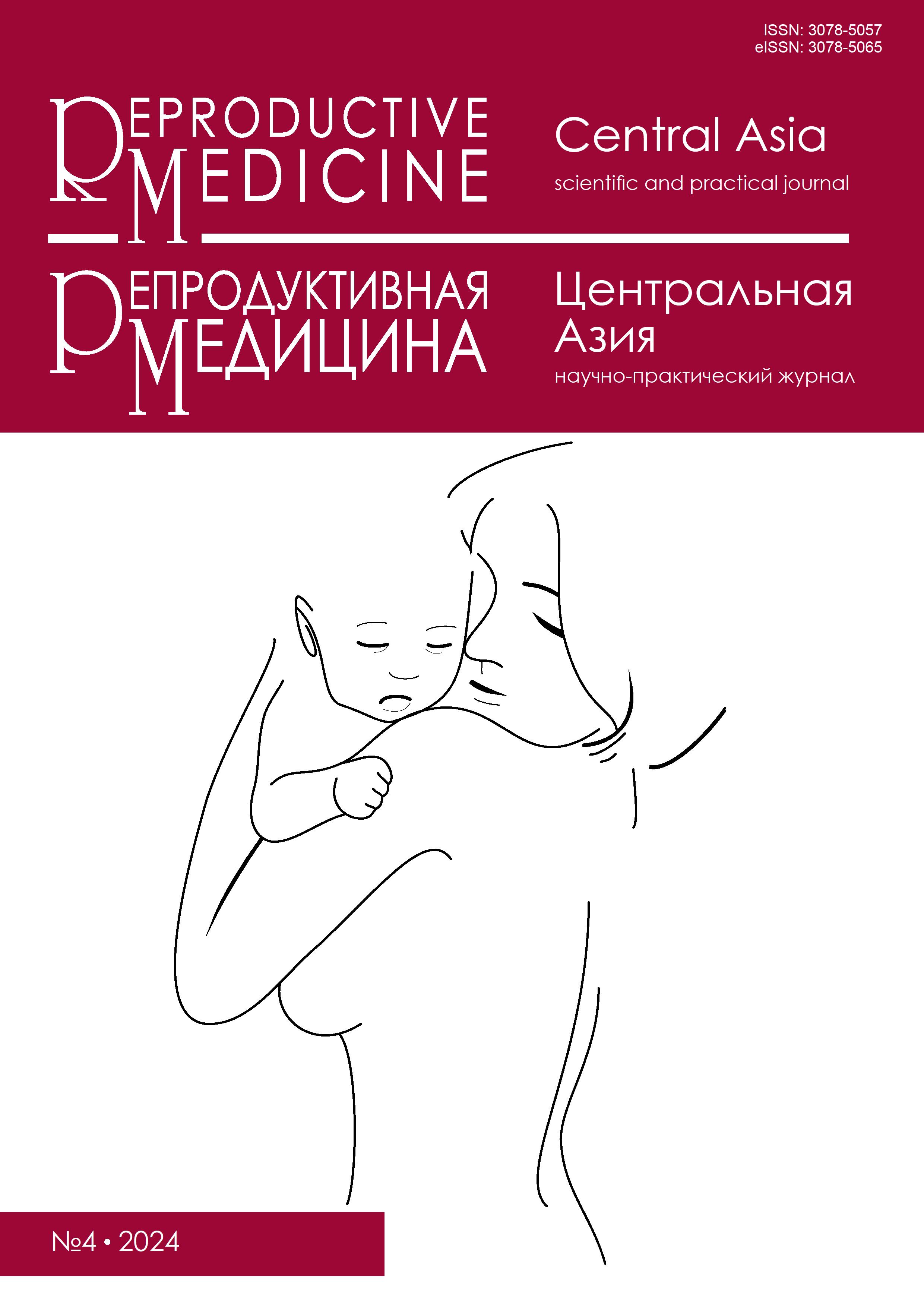Mean platelet volume, corpuscular volume, and hemoglobin levels impact the risk of severe preeclampsia in pregnancy
DOI:
https://doi.org/10.37800/RM.4.2024.412Keywords:
preeclampsia, mean platelet volume (MPV), mean corpuscular volume (MCV), hemoglobin (Hb), logistic regression, biomarkersAbstract
Relevance: Preeclampsia is one of the most severe complications of pregnancy, characterized by the development of arterial hypertension and proteinuria after the 20th week of gestation. In recent years, increasing interest has been shown in the study of hematological parameters as potential biomarkers for early diagnosis and prediction of preeclampsia. Mean platelet volume (MPV) is an indicator reflecting the size and activity of platelets. An increase in MPV could indicate platelet activation and an inflammatory process. Mean corpuscular volume (MCV) characterizes the average length of red blood cells and could indicate various hematological disorders.
The study aimed to assess the impact of MPV, MCV, and Hb levels on the risk of developing severe preeclampsia in pregnant women.
Materials and Methods: The study included 85 pregnant women divided into two groups: 55 women with severe preeclampsia (Group 1) and 30 healthy pregnant women (Group 2).
We conducted a multivariate analysis using logistic regression to assess the impact of these parameters on the risk of preeclampsia. We defined inclusion and exclusion criteria. The model’s accuracy was evaluated using ROC analysis.
Results: The multivariate analysis revealed that elevated MCV and MPV values were associated with a reduced risk of developing severe preeclampsia, while elevated hemoglobin (Hb) levels were associated with an increased risk. Notably, the model demonstrated a high predictive accuracy, instilling confidence in the study's results with an AUC = 0.82.
Conclusion: The study's findings suggest that MCV, MPV, and Hb parameters can significantly predict the risk of severe preeclampsia. Their potential use in clinical practice could offer hope for early diagnosis and prevention of this pregnancy complication, potentially improving outcomes for pregnant women.
References
Redman CW, Sargent IL. Latest advances in understanding preeclampsia. Science. 2005;308(5728):1592-1594.
https://doi.org/10.1126/science.1111726
Sibai BM. Diagnosis and management of gestational hypertension and preeclampsia. Obstet Gynecol. 2005;105(2):402-410.
https://doi.org/10.1016/s0029-7844(03)00475-7
Roberts JM, Hubel CA. The two-stage model of preeclampsia: variations on the theme. Placenta. 2009;30 Suppl A.
https://doi.org/10.1016/j.placenta.2008.11.009
Bálint A. Novel molecular biological markers of preeclampsia. PhD thesis. 2023
https://doi.org/10.14753/SE.2023.2919
Ghulmiyyah L, Sibai B. Maternal mortality from preeclampsia/eclampsia. Semin Perinatol. 2012;36(1):56-59.
https://doi.org/10.1053/j.semperi.2011.09.011
AlSheeha R, Alaboudi MA, Alghasham J, Iqbal J, Adam I. Platelet and leukocyte activation in preeclampsia. J Obstet Gynaecol Res. 2006;32(5):408-414.
https://doi.org/10.2147/VHRM.S120944
Gasparyan AY, Ayvazyan L, Mikhailidis DP, Kitas GD. Mean platelet volume: a link between thrombosis and inflammation? Curr Pharm Des. 2011;17(1):47-58.
https://doi.org/10.2174/138161211795049804
Hoffmann JJ. Red blood cell and platelet distribution width in triage and risk assessment. J Lab Precis Med. 2017;2:43.
https://www.researchgate.net/publication/334084055
Stevens A, Lowe J. Human Histology. 3rd ed. Elsevier Mosby; 2005.
https://archive.org/details/humanhistology0000stev
American College of Obstetricians and Gynecologists. Gestational hypertension and preeclampsia: ACOG practice bulletin summary, number 222. Obstet Gynecol. 2020;135(6):1492-1495.
https://doi.org/10.1097/aog.0000000000003891
Dundar O, Yoruk P, Tutuncu L, Erikci A, Muhcu M, Ergur A, Atay V, Mungen E. A longitudinal study of platelet size changes in gestation and predictive power of elevated MPV in development of pre-eclampsia. Prenat Diagn. 2008;28(11):1052-1056.
https://doi.org/10.1002/pd.2126
Hübinette A, Lichtenstein P, Brismar K, Vatten L, Jacobsen G, Ekbom A, Cnattingius S. Serum insulin-like growth factors in normal pregnancy and pregnancies complicated by preeclampsia. Acta Obstet Gynecol Scand. 2003;82(11):1004-9.
http://dx.doi.org/10.1080/j.1600-0412.2003.00034
Socol ML, Weiner CP, Louis G, Rehnberg K, Rossi EC. Platelet activation in preeclampsia. Am J Obstet Gynecol. 1985 Feb 15;151(4):494-7.
https://doi.org/10.1016/0002-9378(85)90276-5
Roberts JM, Taylor RN, Musci TJ, Rodgers GM, Hubel CA, McLaughlin MK. Preeclampsia: an endothelial cell disorder. Am J Obstet Gynecol. 1989 Nov;161(5):1200-4. https://doi.org/10.1016/0002-9378(89)90665-0
Paliogiannis P, Zinellu A, Mangoni AA, Capobianco G, Dessole S, Cherchi PL, Carru C. Red blood cell distribution width in pregnancy: a systematic review. Biochem Med (Zagreb). 2018 Oct 15;28(3):030502. https://pmc.ncbi.nlm.nih.gov/articles/PMC6214699
Catarino C, Rebelo I, Belo L, Rocha-Pereira P, Rocha S, Bayer Castro E, Patrício B, Quintanilha A, Santos-Silva A. Erythrocyte changes in preeclampsia: the relationship between maternal and cord blood erythrocyte damage. J Perinat Med. 2009;37(1):19-27.
https://pubmed.ncbi.nlm.nih.gov/18783307/
Sankaran S, Kyle PM. Aetiology and pathogenesis of IUGR. Best Pract Res Clin Obstet Gynaecol. 2009;23(6):765-777.
https://doi.org/10.1016/j.bpobgyn.2009.05.003
Steer PJ. Maternal hemoglobin concentration and birth weight. Am J Clin Nutr. 2000;71(5):1285S-1287S.
https://doi.org/10.1093/ajcn/71.5.1285s
Сафарова К., Омертаева Д., Мугазов М., Амирбекова Ж., Увашева А., Акжол Г. Влияние материнского микробиома на развитие преэклампсии: обзор литературы. Репродуктивная медицина (Центральная Азия). 2024;1:44-51.
Safarova К, Omertayeva D, Mugazov М, Amirbekova Zh, Uvasheva А, Akzhol G. The influence of the maternal microbiome on the development of preeclampsia: A literature review. Reproductive Medicine (Central Asia). 2024;1:44-51.
Downloads
Published
How to Cite
Issue
Section
License
Copyright (c) 2024 The rights to a manuscript accepted for publication are transferred to the Journal Publisher. When reprinting all or part of the material, the author must refer to the primary publication in this journal.

This work is licensed under a Creative Commons Attribution-NonCommercial-NoDerivatives 4.0 International License.
The articles published in this Journal are licensed under the CC BY-NC-ND 4.0 (Creative Commons Attribution – Non-Commercial – No Derivatives 4.0 International) license, which provides for their non-commercial use only. Under this license, users have the right to copy and distribute the material in copyright but are not permitted to modify or use it for commercial purposes. Full details on the licensing are available at https://creativecommons.org/licenses/by-nc-nd/4.0/.




